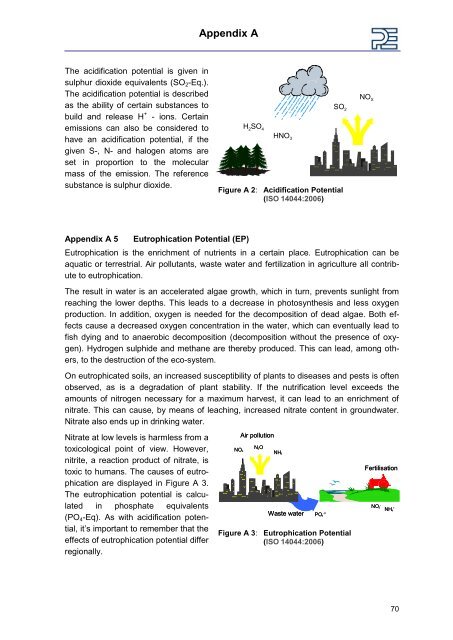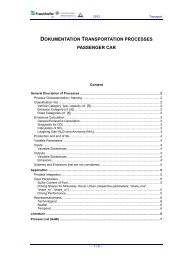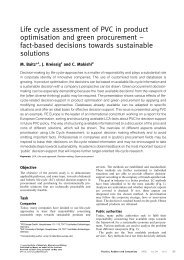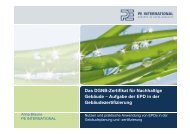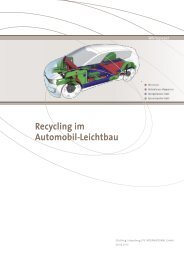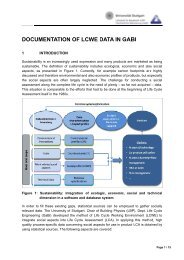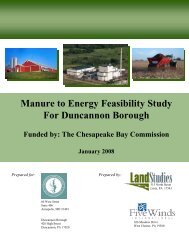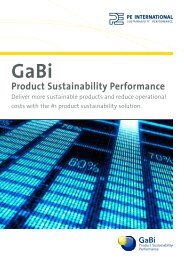GaBi Paper Clip Tutorial - GaBi Software
GaBi Paper Clip Tutorial - GaBi Software
GaBi Paper Clip Tutorial - GaBi Software
Create successful ePaper yourself
Turn your PDF publications into a flip-book with our unique Google optimized e-Paper software.
The acidification potential is given in<br />
sulphur dioxide equivalents (SO2-Eq.).<br />
The acidification potential is described<br />
as the ability of certain substances to<br />
build and release H + - ions. Certain<br />
emissions can also be considered to<br />
have an acidification potential, if the<br />
given S-, N- and halogen atoms are<br />
set in proportion to the molecular<br />
mass of the emission. The reference<br />
substance is sulphur dioxide.<br />
Appendix A<br />
Appendix A 5 Eutrophication Potential (EP)<br />
Figure A 2: Acidification Potential<br />
(ISO 14044:2006)<br />
Eutrophication is the enrichment of nutrients in a certain place. Eutrophication can be<br />
aquatic or terrestrial. Air pollutants, waste water and fertilization in agriculture all contribute<br />
to eutrophication.<br />
The result in water is an accelerated algae growth, which in turn, prevents sunlight from<br />
reaching the lower depths. This leads to a decrease in photosynthesis and less oxygen<br />
production. In addition, oxygen is needed for the decomposition of dead algae. Both effects<br />
cause a decreased oxygen concentration in the water, which can eventually lead to<br />
fish dying and to anaerobic decomposition (decomposition without the presence of oxygen).<br />
Hydrogen sulphide and methane are thereby produced. This can lead, among others,<br />
to the destruction of the eco-system.<br />
On eutrophicated soils, an increased susceptibility of plants to diseases and pests is often<br />
observed, as is a degradation of plant stability. If the nutrification level exceeds the<br />
amounts of nitrogen necessary for a maximum harvest, it can lead to an enrichment of<br />
nitrate. This can cause, by means of leaching, increased nitrate content in groundwater.<br />
Nitrate also ends up in drinking water.<br />
Nitrate at low levels is harmless from a<br />
toxicological point of view. However,<br />
nitrite, a reaction product of nitrate, is<br />
toxic to humans. The causes of eutrophication<br />
are displayed in Figure A 3.<br />
The eutrophication potential is calculated<br />
in phosphate equivalents<br />
(PO4-Eq). As with acidification potential,<br />
it‟s important to remember that the<br />
effects of eutrophication potential differ<br />
regionally.<br />
NOX NOX<br />
H 2SO 44<br />
Air pollution<br />
N2O<br />
HNO 3<br />
NH3 NH3<br />
Waste water<br />
PO4 -3<br />
PO4 -3<br />
SO 2<br />
Figure A 3: Eutrophication Potential<br />
(ISO 14044:2006)<br />
NO X<br />
Fertilisation<br />
NO3 - NO3 -<br />
+<br />
NH4 NH4<br />
70


